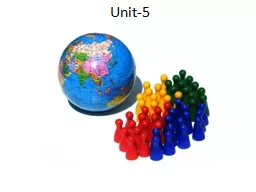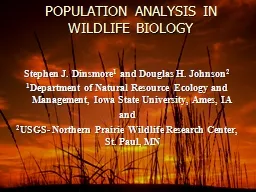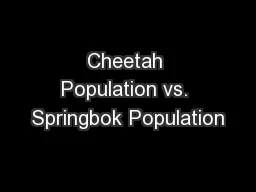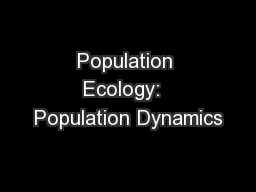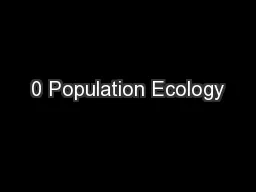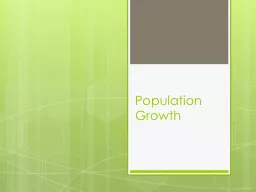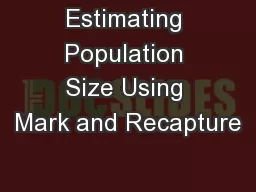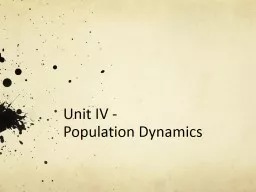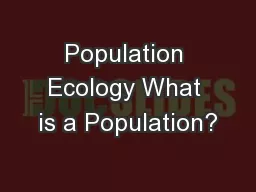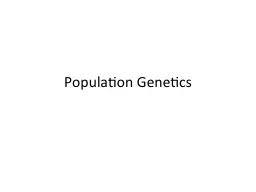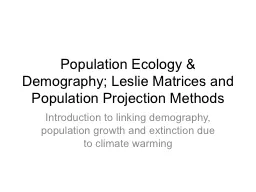PPT-Unit-5 4. Population size : objectives
Author : stefany-barnette | Published Date : 2018-11-23
Core Define population as a group of organisms of one species living in the same area at the same time State the factors affecting the rate of population growth
Presentation Embed Code
Download Presentation
Download Presentation The PPT/PDF document "Unit-5 4. Population size : objectives" is the property of its rightful owner. Permission is granted to download and print the materials on this website for personal, non-commercial use only, and to display it on your personal computer provided you do not modify the materials and that you retain all copyright notices contained in the materials. By downloading content from our website, you accept the terms of this agreement.
Unit-5 4. Population size : objectives: Transcript
Core Define population as a group of organisms of one species living in the same area at the same time State the factors affecting the rate of population growth for a population of an organism limited to food supply predation and disease and describe their importance Identify the lag exponential log stationary and death phases in the sigmoid population growth curve for a population growing in an environment with limited resources. 1 Introduction 2 Demographic and other assumptions 3 Indicators from Spectrum Stephen J. Dinsmore. 1. and Douglas H. Johnson. 2. 1. Department of Natural Resource Ecology and Management, Iowa State University, Ames, IA. and. 2. USGS- Northern Prairie Wildlife Research Center, St. Paul, MN. By: Taylor Thomason. Heather Caldwell. Intro. In this project we observed the effect the cheetah population had on the springbok population. . We discovered that through this the correlation between the two is positively moderate.. Image from Wikimedia Commons. Global human population. United Nations . projections (2004) . (. red. , . orange. , . green. ). . U. S. Census Bureau modern (. blue. ) . & historical . (. black. ) . Population ecologists are primarily interested in . understanding how biotic and abiotic factors . influence the density, distribution, size, and age structure of populations.. the overall vitality of a population of organisms.. Factors Affecting Population Growth. Populations grow and shrink in response to abiotic and biotic factors.. Abiotic. – physical & chemical factors such as water & light availability, soil structure, salinity, pH, etc.. 27-750. Texture, Microstructure & Anisotropy. A.D. Rollett. Last revised: . 24. th. . March . 2016. 2. Outline. Objectives. Motivation. Quantities, . definitions . measurable . Derivable. Problems that use . Estimating Population Size. Integral part of population dynamics . Helps ecologists see changes over time. Estimating Mobile Organisms. How would you estimate a population of mice?. Size. Increased by. Decreased by. . Calculations. r = (b – d) (i – e) . Local Population Changes. Global Population Changes. Density. What is it?. . Does the predator or the prey control it?. Review of Type I & Type II Errors. When we conduct a test of any hypothesis regardless of the test used we make one of two possible decisions:. Reject the null (H. o. ) in favor of the alternative (H. An interbreeding group of the . same species. living in the same general area. may be distinguished by natural or . . arbitrary boundaries. Population Density vs Dispersion. the number of individuals per unit area or volume. is concerned with the question of whether a particular allele or genotype will become more common or less common over time in a population, and Why.. Example: . Given that the CCR5-. D. 32 allele confers immunity to HIV, will it become more frequent in the human population over time?. for . clinical. . trials. Dr Greg Fox. University. of Sydney, . Australia. Overview. Selecting a suitable study population to answer our research question: where? who’s in? who’s out?. Minimising. Introduction to linking demography, population growth and extinction due to climate warming. What is Population Ecology? . Goal is to understand . factors. and . processes. that govern . abundance.
Download Document
Here is the link to download the presentation.
"Unit-5 4. Population size : objectives"The content belongs to its owner. You may download and print it for personal use, without modification, and keep all copyright notices. By downloading, you agree to these terms.
Related Documents

